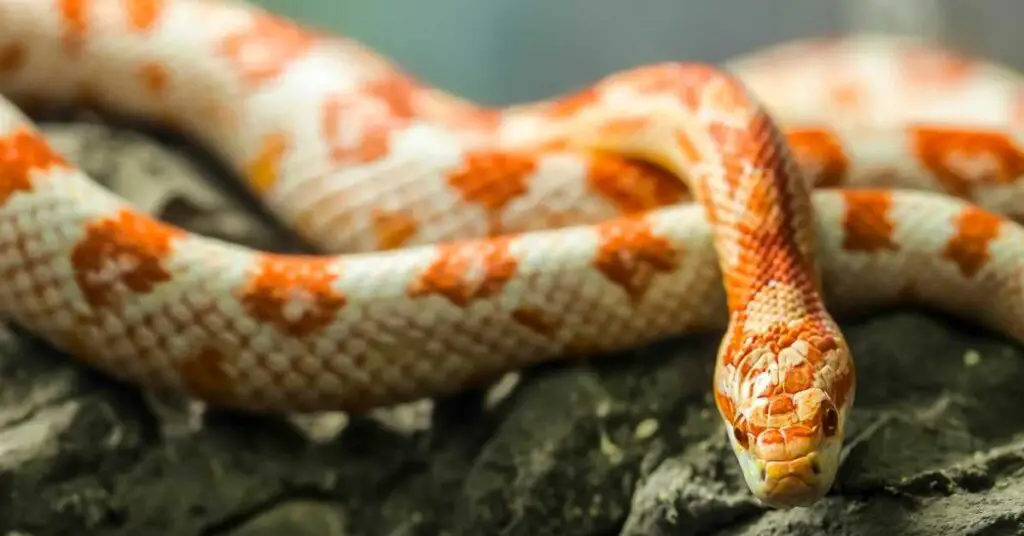Have you ever wondered if corn snakes, those vibrant and captivating reptiles, pose any danger to humans? Well, let’s explore the topic together and uncover the truth.
While corn snakes may not be known for their aggression, it is important to consider their physical characteristics and behavior, as mishandling them can lead to potential dangers.
Moreover, there are certain health risks and diseases associated with these snakes that require careful attention.
So, grab your curiosity and let’s dive into the fascinating world of corn snakes to uncover whether they truly are dangerous or not.
Key Takeaways
- Corn snakes are generally docile and calm, but mishandling can cause injury or stress to both the snake and handler.
- Proper support is necessary during handling to prevent slipping or falling accidents.
- Mishandling a corn snake after feeding can result in defensiveness or agitation.
- There is a potential risk of zoonotic diseases, such as Salmonella, so good hygiene practices and regular veterinary check-ups are important when handling corn snakes.
Physical Characteristics of Corn Snakes
Corn snakes possess distinct physical characteristics that make them easily recognizable among other snake species. One of the most notable features of corn snakes is their wide range of color variations. These snakes can be found in a spectrum of colors, including red, orange, yellow, and brown, often with patterns that resemble corn kernels or maize. This variation in color allows them to blend in with their natural habitat, which primarily includes grasslands, forests, and farmlands throughout the southeastern United States. Their ability to adapt to different environments and camouflage themselves is a survival mechanism that helps them avoid predators and hunt for prey.
In addition to their vibrant colors, corn snakes have slender bodies and smooth scales that give them a sleek appearance. They typically have a length of three to five feet, although some individuals can reach up to six feet. Their eyes, which are round and dark, provide excellent vision, allowing them to accurately locate their prey. Corn snakes also have a specialized heat-sensitive organ called pit organs, located on either side of their head, which helps them detect warm-blooded animals even in the dark.

Understanding the Behavior of Corn Snakes
After examining the physical characteristics of corn snakes, it’s important to delve into their behavior and gain a better understanding of how these snakes behave in their natural habitat. Corn snakes are known for their docile and calm nature, making them popular pets among reptile enthusiasts. They’ve a curious and explorative personality, often found climbing trees or hiding in crevices.
In terms of breeding patterns, corn snakes are oviparous, meaning they lay eggs. They usually mate in the spring or early summer, with males actively seeking out females by following their scent trails. Once the female is fertilized, she’ll lay a clutch of eggs, typically ranging from 10 to 30 eggs, in a warm and secluded area.
Corn snakes are native to the southeastern United States and can be found in a variety of habitats, including forests, grasslands, and even urban areas. They’re excellent climbers and are often spotted in trees or shrubs. Their diet primarily consists of small mammals, such as mice and rats, as well as birds and their eggs.
Understanding these behavioral patterns and natural habitat of corn snakes is crucial for their proper care and well-being in captivity. By providing them with a suitable environment and an appropriate diet, corn snakes can thrive and become beloved companions for those who appreciate their gentle nature.
Potential Dangers of Mishandling Corn Snakes
Mishandling corn snakes can pose potential dangers if proper care and handling techniques aren’t followed. It’s important to understand the correct handling techniques for corn snakes to ensure the safety of both the snake and the handler. Here are three common mistakes to avoid when handling corn snakes:
- Rough handling: Corn snakes are delicate creatures and should be handled with care. Avoid applying too much pressure or squeezing the snake, as this can cause injury or stress.
- Improper support: When handling a corn snake, it’s crucial to support its body properly. Always provide full support by holding the snake with both hands, one towards the front and the other towards the tail. This helps to prevent the snake from slipping or falling.
- Mishandling during feeding: It’s important to be cautious when handling a corn snake that has recently been fed. Snakes may be more defensive or agitated after eating, so it’s recommended to wait at least 48 hours before handling them.
Health Risks and Diseases Associated With Corn Snakes
There are several health risks and diseases that can be associated with handling corn snakes. One of the main concerns is the potential transmission of zoonotic diseases from corn snakes to humans. While the risk is relatively low, it’s still important to take precautions when handling these reptiles to minimize the chances of infection.
Zoonotic diseases are diseases that can be transmitted between animals and humans. Although corn snakes are generally considered to be safe and non-venomous, they can still carry bacteria and parasites that may cause illness in humans. Salmonella is one such example. It’s a common bacteria found in the digestive tracts of reptiles, including corn snakes. While healthy individuals may not experience severe symptoms, those with weakened immune systems, such as children, the elderly, and pregnant women, are at a higher risk of developing complications.
To reduce the risk of zoonotic diseases transmission, it’s crucial to practice good hygiene after handling corn snakes. This includes washing your hands thoroughly with soap and water, especially before eating or preparing food. It’s also advisable to avoid touching your face or mouth while handling snakes and to clean any surfaces or objects that come into contact with them.
In addition to practicing good hygiene, regular veterinary check-ups are essential for the overall health and well-being of corn snakes. A qualified veterinarian will be able to assess the snake’s condition, provide necessary vaccinations, and check for any signs of illness or parasites. By detecting and treating any potential health issues early on, you can ensure the longevity and happiness of your corn snake.
Safety Precautions for Handling Corn Snakes
To ensure the safe handling of corn snakes and minimize the risk of zoonotic diseases, it’s important to follow proper safety precautions. These precautions involve using the right techniques and necessary equipment.
Here are three important safety measures to keep in mind when handling corn snakes:
- Wash your hands before and after handling: This simple step helps prevent the transmission of any potential bacteria or parasites from the snake to you. Use warm water and soap, and make sure to thoroughly clean your hands.
- Use gentle and controlled movements: Corn snakes are generally docile, but sudden or rough movements can startle them. This may lead to defensive behaviors such as biting or musking. To avoid this, handle the snake with gentle and controlled movements, supporting its body properly.
- Wear protective gear: Although corn snakes aren’t venomous, it’s still a good idea to wear gloves when handling them. Gloves not only protect you from potential bites but also provide a barrier against any bacteria or parasites that the snake may carry.
Frequently Asked Questions
Can Corn Snakes Bite?
Yes, corn snakes can bite, but it is important to understand their behavior. To minimize the risk, take precautions while handling them, such as approaching calmly and supporting their body.
How Long Do Corn Snakes Usually Live?
On average, corn snakes usually live for 10-15 years. However, their lifespan can be influenced by various factors such as diet, habitat conditions, and overall health.
Can Corn Snakes Be Kept as Pets?
Corn snakes can be kept as pets. They have pros, such as being low maintenance and relatively docile. However, cons include potential health issues and the need for a suitable habitat. Tips for success involve proper feeding, handling, and creating a secure environment.
Are Corn Snakes Venomous?
Corn snakes are not venomous and their bites are generally harmless. While they may bite if they feel threatened, their bite is similar to a mild pinch. With proper handling and care, corn snakes pose no significant danger.
Do Corn Snakes Require Any Special Care or Habitat?
When caring for a corn snake, it’s important to provide a special habitat and meet their dietary needs. You’ll need to learn proper handling techniques to ensure the snake’s well-being and safety.
Conclusion
In conclusion, while corn snakes may not be inherently dangerous, mishandling or improper care can pose risks. It’s important to understand their physical characteristics and behavior to ensure safe handling.
Additionally, being aware of potential health risks and diseases associated with corn snakes is crucial for their well-being and the safety of their owners.
By taking necessary safety precautions and maintaining proper care, corn snakes can be enjoyed as fascinating pets without posing significant dangers.


